How to Train Your AI Model (and Use It to Create Infinite Content) | ImagineArt
Train your own AI model in minutes — from characters to products to visual styles. Create consistent, branded content across images and videos using your fully custom model. No code, no guesswork, just repeatable results.

Saba Sohail
Tue Jul 22 2025
8 mins Read
In Image Studio, you can now train your own AI model — create a person, product, or style — and use it everywhere, without re-prompts, reshoots, or design tweaks. This guide shows you exactly how it works (and why you’ll never go back to stock visuals again).
What Is AI Model Training?
Imagine creating a character once — and reusing them across reels, thumbnails, product shots, and even cinematic videos? Or teaching an AI your brand’s exact look, so every image you generate fits your identity perfectly?
That’s what ImagineArt has unlocked with its newest AI model training feature.
In creative workflows, AI model training means teaching an AI system to understand and replicate a very specific visual identity — for person, a product, or a style.
Unlike generic image generation, where you write prompts and hope for something close, trained models actually learn from reference images.
The result?
A reusable visual asset you can generate again and again — with total consistency.
So when you’re building a character for a story, showing off a product in different settings or mockups, or applying a brand style across hundreds of creatives, model training makes your AI outputs more reliable, more branded, and far more scalable.
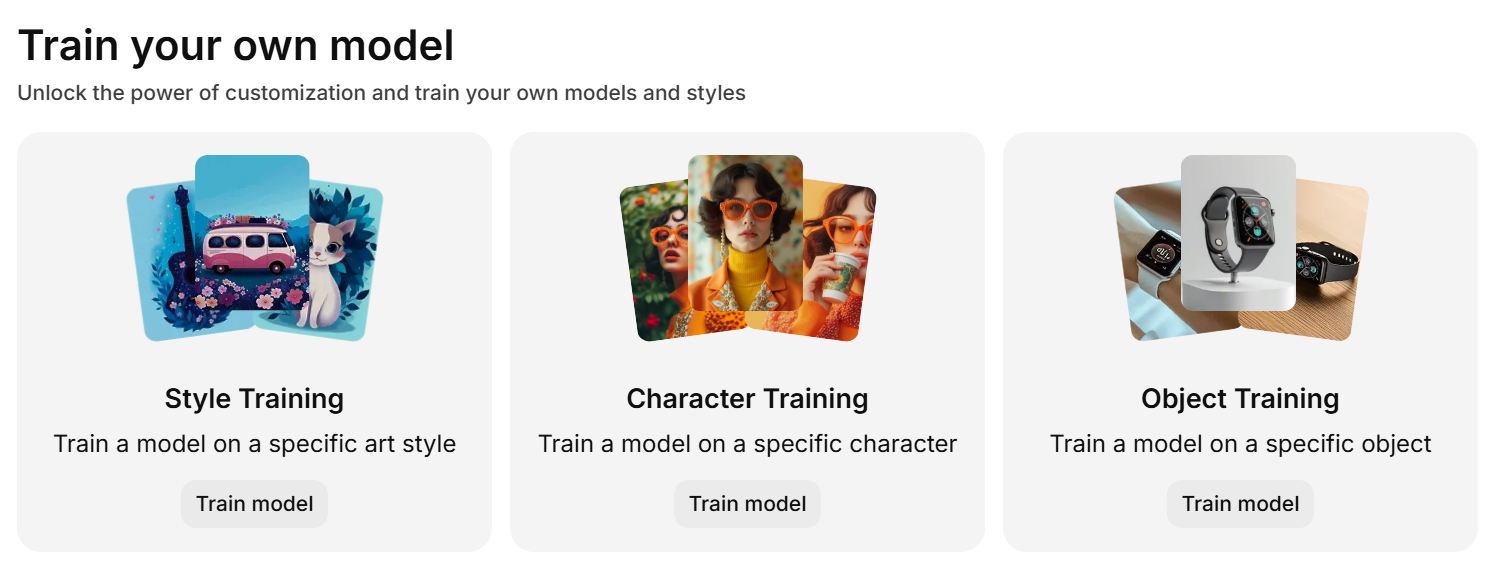 Training your own AI model
Training your own AI model
How AI Model Training Works in ImagineArt
At ImagineArt, training your own AI model is as simple as it gets — no code, no setup, no technical headaches. Inside Image Studio, users can create models in three distinct categories:
1. Character Model Training
Train the AI to recognize and reproduce a consistent character — whether it’s a real person, fictional figure, or digital avatar. Perfect for influencers, mascots, or storytelling.
2. Object Model Training
Upload your product from different angles and teach the AI how it looks — so it can appear accurately in any environment, lighting, or creative scene you generate.
3. Style Model Training
Feed the AI a curated batch of visuals — like your brand’s mood, your illustration style, or a signature aesthetic — and generate new content in that exact look.
When training a model for people, products, or creative direction, the process is fast and super organized
- just upload images
- name the model and add a model description
- generate.
No tweaking, no coding — and once trained, your models become instantly reusable across Image Studio and Video Studio (through the ‘Animate’ feature.)
You can also explore 100s of ready-made models trained by the ImagineArt team and its community — from lifestyle characters to high-gloss product shots to unique illustrated styles — and use them for inspiration or generation.
How to Train Your First AI Model in 3 Steps
Now that you know what model training is and the three types ImagineArt supports, let’s break down how easy it is to get started.
Step 1: Upload Your Reference Images
Decide what you’d like to train the model for:
- a character
- a product/object
- a style
Start by uploading between 5 and 50 high-resolution images (512×512 pixels or larger).
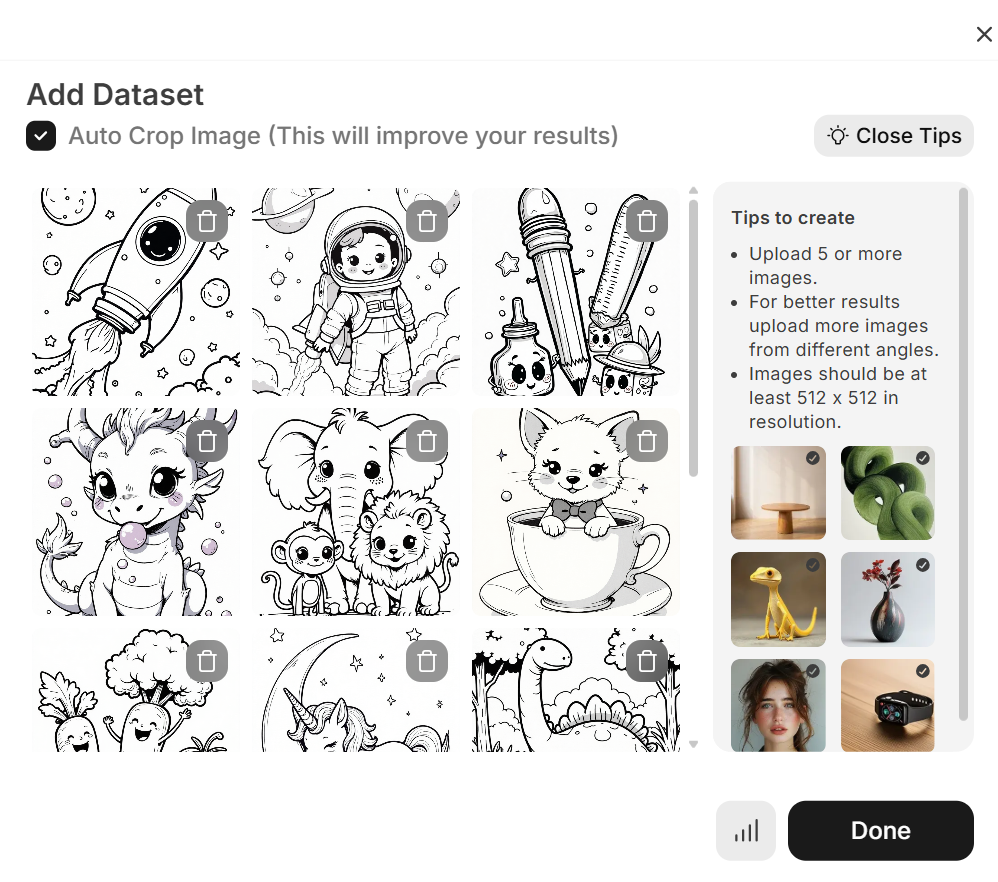 Step 1
Step 1
These images should clearly show what you’re training — a face, a product, or a signature aesthetic.
The model training feature asks you for at least 5 high-res images, yet I would recommend adding at least 12 — and from different views to teach the model how exactly your model looks from different angle.
I added around 12 to train my model for ‘coloring pages’.
The better your references, clean, varied, well-lit, the more accurate and reusable your model will be.
For characters, I recommend uploading images where the person is standing (full portrait), 2-3 front facial views, 1 where you character is sitting so AI can see posture and rest 3-4 random shots doing different activities.
For objects/products, place them on different backgrounds — make sure the front is clear.
If your product has a text heavy packaging, I recommend training 2 models — one for front view the other for the text stuff.
For style, the more pictures you feed, the easier it is for AI to understand your preferences.
Step 2: Name and Describe Your Model
Next, give your model a descriptive name like “Minimalist Product – Matte Glass”, “Luna the Space Explorer”, or “Brand Style – Soft Pastels”.
Then write a short description that captures what the AI should learn — such as the visual texture, color scheme, outfit style, or branding cues. This helps guide the AI’s internal tagging and improves generation later.
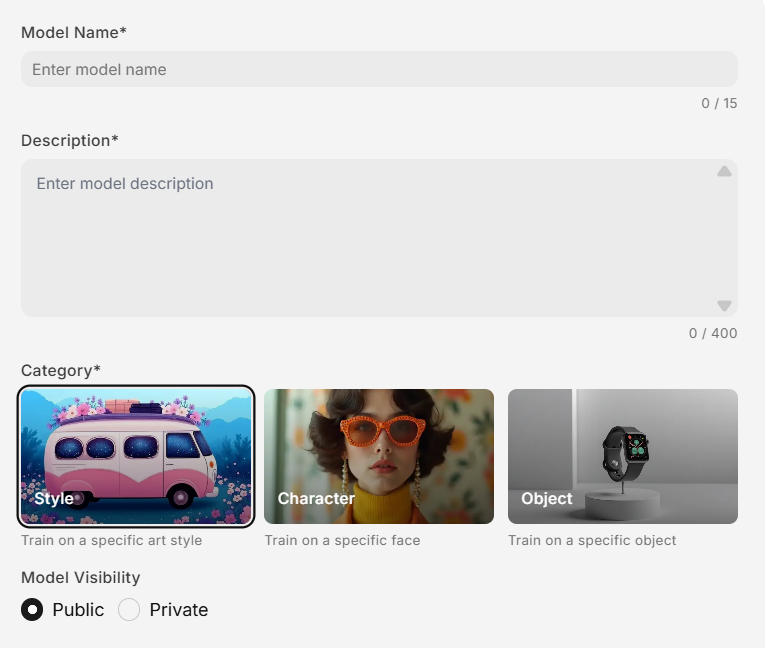 Define your model
Define your model
You can also set the model to 'Public' or 'Private'. If you are training the model for branded social media visuals - set it to 'Private'.
Step 3: Generate and Reuse Anywhere
Once trained, your model is ready to use.
You can now select it in Text-to-Image, Reimagine, and even ‘Animate’ your products and characters. *The animate feature will automatically generate video in Video Studio’.
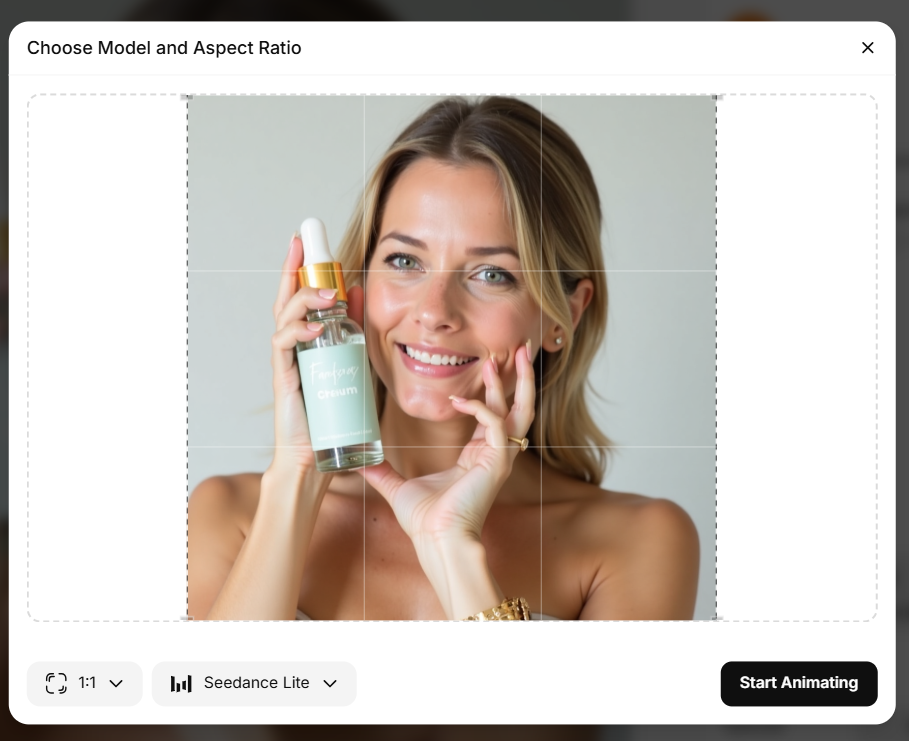 Create a video with your Trained AI Model
Create a video with your Trained AI Model
Ready to create your very-first, very-own AI model?
How to use your Trained AI Model
Now that you’ve seen how AI model training works, let’s explore what you can actually do with it.
From storytelling and branding to product visuals and style replication, here’s how creators and teams are currently using trained models to unlock new creative potential.
Start with Characters — Build Consistent Personas
Character model training is ideal for anyone who wants the same face, vibe, or identity across images and videos.
Once your character is trained, you can generate them in different poses, outfits, expressions, and settings — all while keeping the core look perfectly intact.
1. AI Influencers
Create a lifestyle or niche influencer who can appear across content without needing a real human. Your trained character can model products, pose in stylized settings, or react to cultural trends — all without ever taking a selfie.
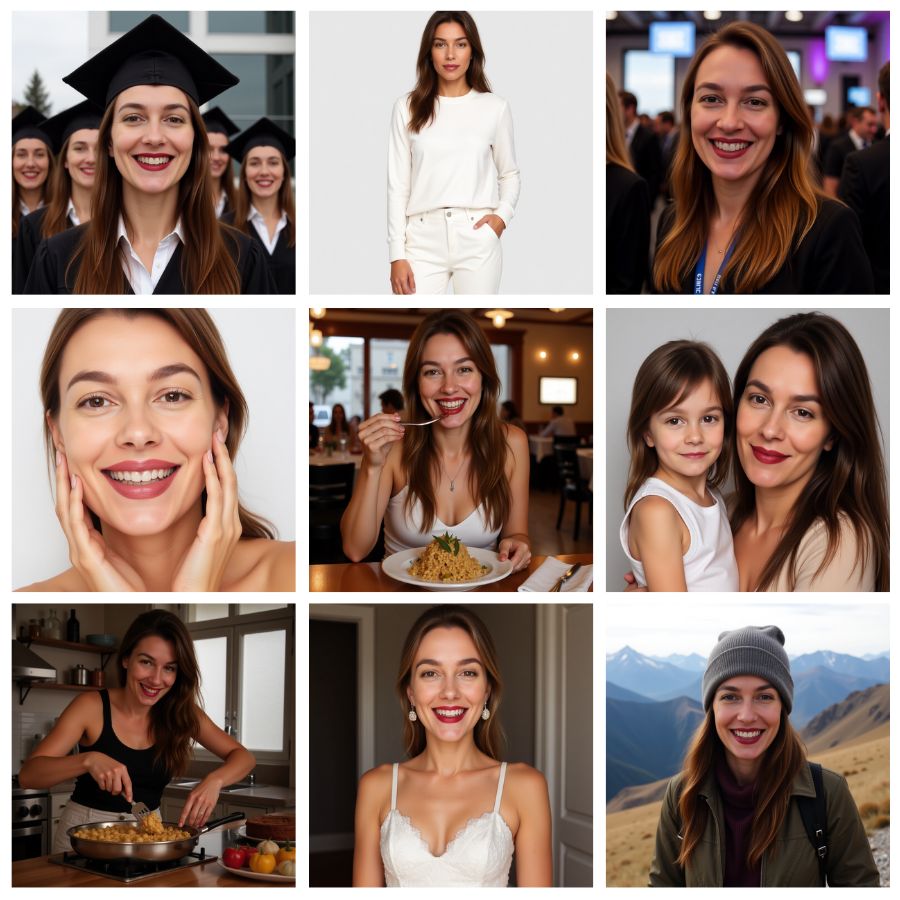 AI Model Training - Character and AI Influencer
AI Model Training - Character and AI Influencer
2. YouTube Thumbnails
Use a consistent avatar for every video — great for faceless creators or channels that want a virtual presenter. Your character can smile, shout, pose, or point, all while matching your content tone.
3. Storytelling & Comics
Writers and illustrators can bring characters to life across entire narratives — page by page, scene by scene. The AI remembers your protagonist’s look, so continuity isn’t lost as the story evolves.
 Style Training - Comics
Style Training - Comics
4. Brand Mascots
Companies can train a visual mascot — a quirky human, robot, or animal — that appears across website banners, ads, packaging, or short videos. One model, infinite use cases.
Move to Products — Train Reusable Object Models
For physical products, packaging, or tools, object model training gives you a scalable way to generate visuals without reshooting or rendering from scratch. Train once, then reuse in every campaign.
5. Product Visuals at Scale
Generate new angles, lighting setups, or zoom levels without ever touching a camera. Perfect for ecommerce, landing pages, or catalog updates.
 Object Training - Product Ads and Photography
Object Training - Product Ads and Photography
6. Lifestyle Campaigns
Drop your product into real-world environments: gym bags, countertops, beaches, bathroom shelves. The object stays consistent while the scene adapts to your message.
 Object Training - Headsets
Object Training - Headsets
7. Catalog Consistency
Use the same trained object to create visuals for Amazon, Shopify, Etsy, and your own site — all aligned with your brand guidelines.
8. A/B Testing for Ads
Rapidly generate multiple versions of the same product ad — different props, backgrounds, and settings — while keeping the core item perfectly consistent.
Lock in Style — Train a Visual Identity
When it comes to design systems, style is everything. With a trained style model, you can apply your unique aesthetic across everything — from product campaigns to illustrations — without having to manually restyle each asset.
9. Branded Social Media
Apply a signature visual theme to every post, story, or reel thumbnail — whether it’s clean minimalism, grunge textures, or soft vintage lighting.
10. Editorial & Content Teams
Magazines and platforms can lock in a house aesthetic — ensuring every article, cover, and campaign asset matches the same visual voice.
11. Artists & Illustrators
Reuse your own drawing, painting, or digital illustration style to speed up production. The AI generates new visuals in your voice, not someone else’s.
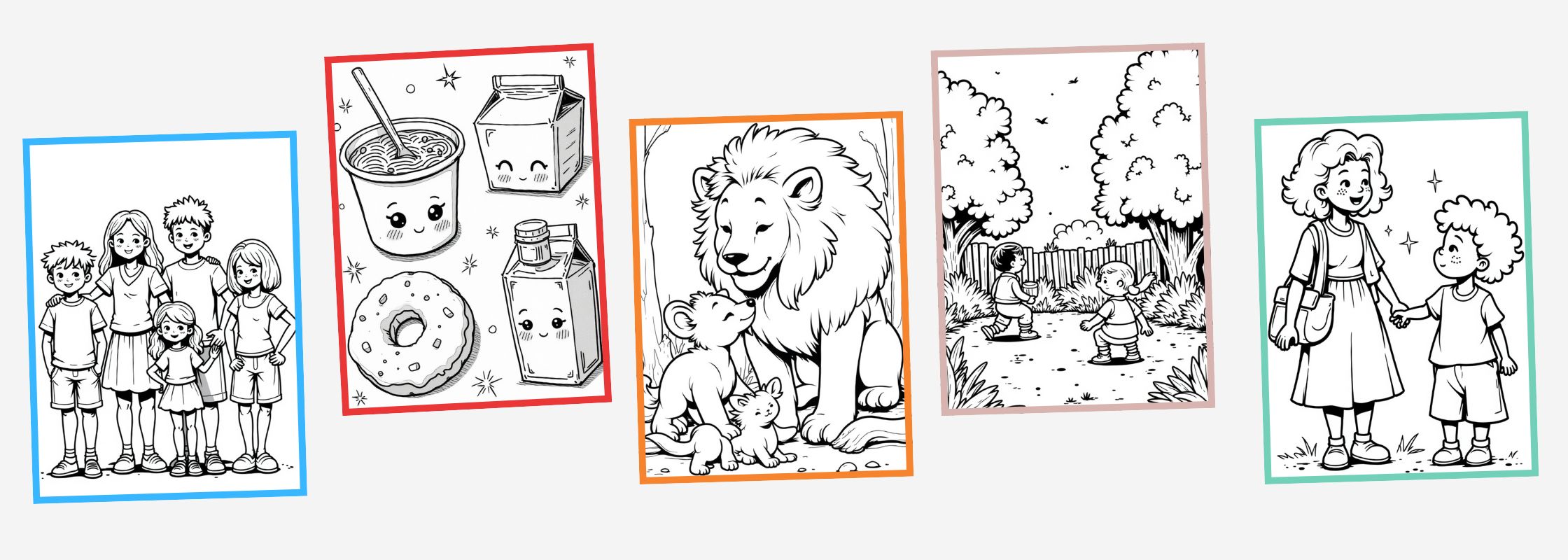 Coloring Pages - Style Training
Coloring Pages - Style Training
12. Agencies & Freelancers
Manage multiple client visual identities without switching tools. Just load the right style model and keep delivering content that looks on-brief — every time.
Benefits of AI Model Training in ImagineArt
Training your own AI model isn’t just about saving time — it’s about building a smarter, more scalable creative process. Here’s how ImagineArt helps you unlock serious advantages with just one model:
1. Visual Consistency, Every Time
No more fighting with prompts to “almost” get it right. Once trained, your model outputs stay visually consistent across scenes, angles, and styles — whether it’s a recurring character, a hero product, or a signature color palette. It’s like having your own digital art director on call.
2. Branded Production for Images and Videos
Trained models don’t just work for still images. You can use them inside Video Studio to create animated and cinematic visuals that carry your branding across product videos, ad spots, or digital storytelling. Your model becomes the anchor point for everything from launch campaigns to explainer clips — always on brand, always recognizable.
3. Speed Without Sacrificing Quality
Generate dozens of campaign-ready visuals in minutes, not days. With your visual identity baked into the model, you can focus on concept and messaging — not fiddling with visual corrections. Ideal for marketing teams, content creators, and designers working on tight deadlines.
4. Eliminate Costly Reshoots and Manual Edits
No more endless back-and-forth with photographers or photo editors. Once you’ve trained a model — of a product, a character, or a visual style — you can remix it endlessly without ever needing a camera, studio, or retouching session again.
5. Ownable Creative IP That Scales
Your trained models are reusable across campaigns, formats, and teams. Whether you’re a solo creator or a full agency, you get to own a custom visual system that evolves with your content — not a one-off asset that expires after a single use.
Who Should Train AI Models?
 Train Your Own AI Model - Benefits
Train Your Own AI Model - Benefits
Ready to create your own AI model in ImagineArt?

Saba Sohail
Saba Sohail is a Generative Engine Optimization and SaaS marketing specialist working in automation, product research and user acquisition. She strongly focuses on AI-powered speed, scale and structure for B2C and B2B teams. At ImagineArt, she develops use cases of AI Creative Suite for creative agencies and product marketing teams.